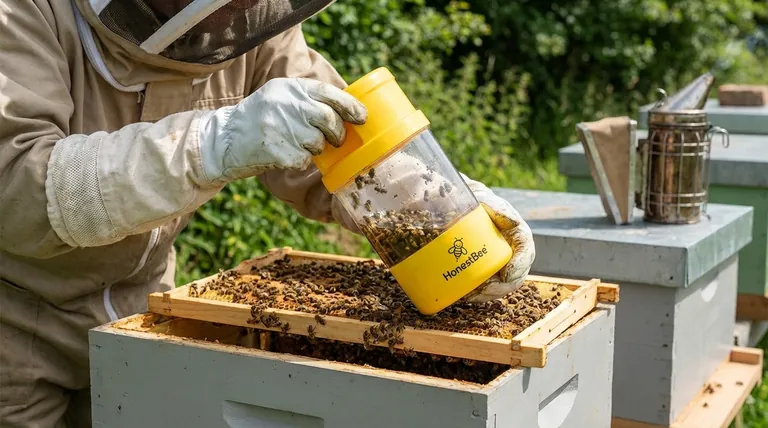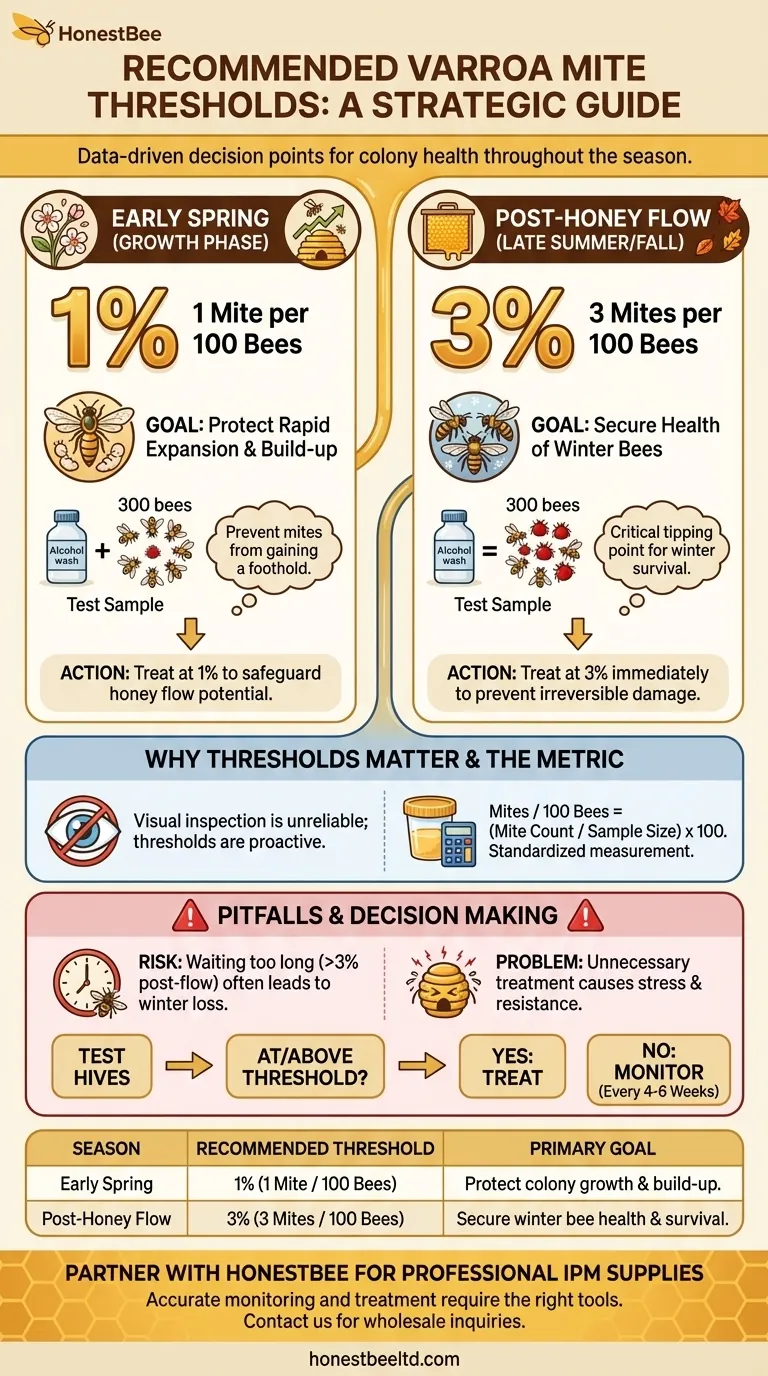For beekeepers, the recommended Varroa mite treatment threshold in early spring is 1 mite per 100 bees (a 1% infestation level). After the main honey flow, typically in late summer or early fall, the threshold to trigger immediate action is 3 mites per 100 bees (a 3% infestation level).
Understanding Varroa mite thresholds is not about memorizing numbers, but about implementing a strategic defense. These figures represent critical decision points in the seasonal cycle, designed to protect the bee population when it is most vulnerable to mite-vectored viruses and population collapse.

Why Mite Thresholds Are Essential Management Tools
Relying on visual inspection for Varroa mites is unreliable; by the time you can easily see mites on adult bees, the infestation is often severe. Thresholds provide a data-driven approach to colony management.
Moving Beyond Guesswork
A treatment threshold is the point at which the mite population is projected to cause significant economic or health damage to the colony. Acting at this level is a proactive measure that prevents the mite population from spiraling out of control.
It replaces reactive treatments—which often occur too late—with a planned strategy based on regular monitoring.
What "Mites per 100 Bees" Means
This metric is a standardized way to measure infestation levels. It is typically determined by taking a sample of approximately 300 bees (a 1/2 cup) and using either an alcohol wash or a powdered sugar roll to dislodge and count the mites.
Dividing the number of mites by the number of bees sampled (e.g., 300) and multiplying by 100 gives you the infestation percentage. For example, 9 mites from a 300-bee sample is a 3% infestation level.
The Logic Behind Seasonal Thresholds
The recommended thresholds for spring and late summer are different because the colony's objectives and vulnerabilities change dramatically throughout the year. The goal is always to protect the most critical bee population for that specific time.
Early Spring (1% Threshold): Protecting the Growth Phase
In spring, the colony's primary goal is rapid expansion. The queen is laying, and the bee population is growing exponentially.
While the total number of mites may be low, their population grows even faster than the bees because they reproduce within the capped brood. A seemingly small 1% infestation can quickly become a major crisis as more brood becomes available.
Treating at this low threshold prevents the mites from gaining a foothold, ensuring the colony can build a large, healthy workforce for the main honey flow.
Post-Honey Flow (3% Threshold): Securing Winter Survival
After the honey flow, the colony's focus shifts from expansion to survival. The queen's laying rate slows, and the colony begins raising the "winter bees" that must live for several months, not just weeks.
These winter bees must be exceptionally healthy to survive the cold and raise the first generation of brood the following spring. Varroa mites weaken these bees and transmit deadly viruses.
A 3% threshold is a critical tipping point. At this level, the mite load is high enough to seriously compromise the health of the developing winter bees. Acting immediately is essential to ensure the colony has a healthy population to survive the winter.
Common Pitfalls to Avoid
Simply knowing the numbers is not enough. The context and timing of your actions are what determine success or failure.
The Risk of Waiting Too Long
Exceeding the post-honey flow threshold of 3% is the most common reason for overwinter colony losses. By the time infestation levels reach 5-7%, the damage to the winter bee population is often irreversible, even if a treatment successfully lowers the mite count.
The Problem with Treating Unnecessarily
Consistently treating when mite levels are well below the threshold can be counterproductive. It adds unnecessary stress to the colony, costs money and labor, and can accelerate the development of mite resistance to the treatment being used. This is why monitoring is the foundation of Integrated Pest Management (IPM).
Making the Right Treatment Decision
Use these thresholds as clear action points in your Varroa management plan.
- If your primary focus is spring build-up: Test your hives and treat any that are at or above a 1% infestation to protect their growth potential.
- If your primary focus is winter survival: Test after removing honey supers and treat any hives at or above a 3% infestation to protect your critical winter bee population.
- If you are below these thresholds: Your management is currently effective. Continue to monitor every 4-6 weeks, as mite populations can change rapidly.
Proactive monitoring and timely action based on established thresholds are the keys to maintaining healthy, productive honey bee colonies.
Summary Table:
| Season | Recommended Threshold (Mites per 100 Bees) | Primary Goal |
|---|---|---|
| Early Spring | 1% | Protect colony growth and build-up for honey flow. |
| Post-Honey Flow (Late Summer/Fall) | 3% | Secure the health of winter bees for colony survival. |
Protect Your Apiary's Vitality with Professional-Grade Supplies
Effective Varroa mite management starts with the right tools for accurate monitoring and treatment. As a trusted wholesale supplier to commercial apiaries and beekeeping equipment distributors, HONESTBEE provides the durable, reliable supplies you need to implement these critical thresholds successfully.
We help you safeguard your colonies and your investment. Let's discuss how our equipment can support your Integrated Pest Management (IPM) strategy.
Contact HONESTBEE today for wholesale inquiries and ensure your colonies thrive season after season.
Visual Guide

Related Products
- Varroa Easy Check Mite Tester Kit Counter Alcohol Wash Jar
- High Performance Plastic Queen Excluder for Beekeeping and Apiary Management
- Metal Queen Bee Excluder for Beekeeping
- Professional Plastic Queen Excluder for Modern Beekeeping
- Premium Wood Framed Metal Wire Queen Bee Excluder
People Also Ask
- Why is an alcohol wash preferred over powdered sugar rolls? For Accurate Varroa Mite Management
- What is the Varroa EasyCheck used for? Accurate Mite Monitoring for Healthy Hives
- How is the infestation percentage calculated after counting mites? Master Varroa Mite Monitoring
- How does the Varroa EasyCheck determine mite counts? Achieve Accurate Hive Health Monitoring
- How often should varroa mite checks be performed using the alcohol wash method? Optimize Your Apiary's Health



















